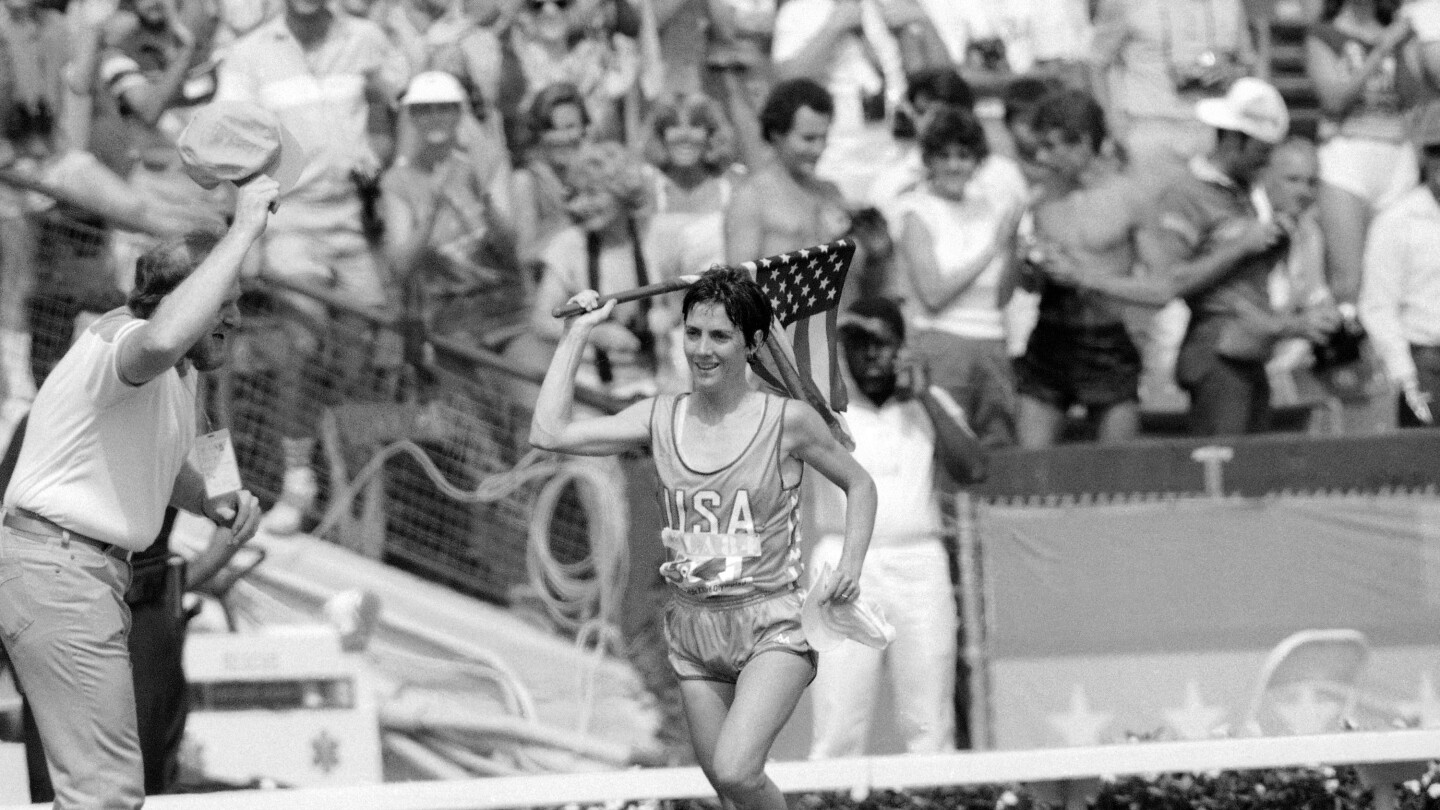PARIS (AP) — There was a time, not that long ago, when those in charge of the Olympics thought it was too dangerous for women to run a marathon.
On Sunday, in a break with tradition that stamps an exclamation point on how much has changed over the last 40 years, the women, not the men, will have the honor of closing out the Olympic track meet with the traditional 26.2-mile run.
Organizers of the Paris Games are using the Sunday women’s marathon as another way to highlight the conquering of a long-sought benchmark at the Olympics; these are the first Summer Games to have an equal number of men and women competing.
In another nod to the historical significance of the moment, the marathon route traces the steps of the Women’s March on Versailles. That was a seminal moment during the French Revolution when women in a Paris marketplace organized a march to Versailles to bring their complaints to King Louis XVI over the high price of bread.
Joan Benoit won the 1st Olympic marathon
Watching all this with interest will be Joan Benoit Samuelson, who won the first Olympic marathon, which wasn’t run until the Los Angeles Games in 1984.
“All these years later, all these centuries later, women are again tracing routes that changed the course of history, and in this case, certainly for the positive,” Samuelson said in an interview with The Associated Press.
For years before Samuelson’s history-making marathon, women were restricted to races of 800 meters or less. The 1,500 was added in 1972. Some of the arguments against women running the longer distances included the idea that they couldn’t handle the psychological stress of long races, and also that the taxing runs could cause infertility.
In 1966, Roberta Gibb, after being denied entry into the Boston Marathon, hid behind a bush near the start line and ran the course.
Not until 1972 were women officially allowed in Boston, and it was another 12 years before the Olympics joined in.
Carey Pinkowski, the executive race director for the Chicago Marathon, said that when he began working with the race in 1990, around 5% of participants were women. He said that now, 50% of the field for Chicago’s race is made up of women.
Joan Benoit ran the highways of LA for first marathon gold
In 1984, the women’s marathon took place on the first Sunday of the Olympic track meet, not the last. The route ran from Santa Monica and went mostly along freeway routes before ending at the LA Coliseum.
Samuelson, then known as Joan Benoit, was the world record holder, but not a favorite because she was coming off knee surgery. Her main competition was the reigning world champion, Grete Waitz. Benoit started fast, finished strong, ran the distance in 2 hours, 24 minutes, 52 seconds and secured her mark in history as the first women’s Olympic marathon winner.
“I sort of lived by the adage, ‘Run your own race’ since that time,” Samuelson said. “You can’t run anybody else’s race in life but your own.”
Biles and Ledecky shined, now a woman marathoner gets center stage
In an Olympics in which Simone Biles, Sha’Carri Richardson and Katie Ledecky dominated the headlines, and where a toxic debate over gender in women’s boxing drove a good portion of the hard news, women will own the spotlight to close out the track meet, the traditional centerpiece of the Games.
“That means most of the people will be watching as they wait for closing ceremonies,” said two-time Olympic 5,000-meter silver medalist Hellen Obiri, the Kenyan standout who is the favorite and is drawing her own new audience as the subject of a documentary titled “ The Heart to Race ” that’s produced by the sportswear company “On.” “It’s a great opportunity for millions of people to watch you. That’s on your mind. I want to work extra hard to make these people happy.”
Obiri and the other 91 women entered in the race will find this journey through Parisian history to be far from an easy stroll. The course is a bruising run, filled with winding inclines that reach grades as steep as 13.5% and is viewed as most difficult the Olympics has seen. There were times Saturday when the men, struggling to negotiate the hills, looked like they were jogging.
“It is simply the toughest course that’s ever been for a major championship, and we believe that makes it the most interesting of tactical races,” said Jon Ridgeon, the former sprinter who is CEO of World Athletics. “I think for the athletes, it makes it more unpredictable. It’s going to be a fascinating mindset.”
For Sifan Hassan, the marathon will be her third race of the Olympics
If only the decision-makers from a generation ago — the leaders who thought women were too fragile to run long distances — could see what Sifan Hassan is doing this week.
Not 48 hours after winning the bronze medal in the 10,000 meters for her second distance bronze of the Paris Games, Hassan, the Ethiopian-born runner who competes for the Netherlands, will trade the track at the Stade de France for the brutal marathon course.
She also ran two 5,000-meter races and finished third in the final there. If Hassan is able to wind her way through this hilly tour of French history, then finally past the Esplanade des Invalides and across the finish line, she will have run more than 62 kilometers over the span of nine days — more than any person, man or woman, at the Paris Games.
If she wins a medal, she will duplicate her feat from the Tokyo Games, when she won three medals in three distance events. That time, she ran the 1,500, not the marathon.
“Endurance on Sunday, that’s not a joke,” Hassan said. “To finish the marathon is a kind of hell. It’s not easy.”
___
AP Summer Olympics: https://apnews.com/hub/2024-paris-olympic-games

